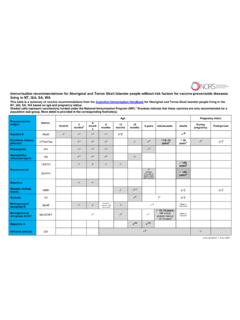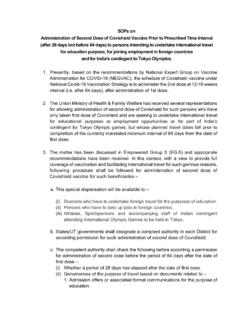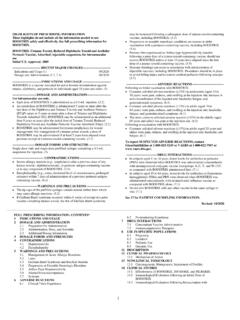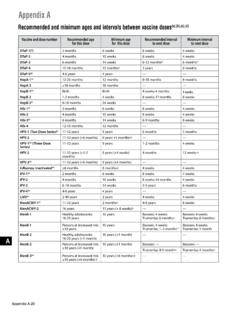Transcription of Meningococcal vaccines for Australians - NCIRS
1 Meningococcal vaccines for Australians | 1 July 2020 Fact sheet 1 Meningococcal vaccines for Australians This fact sheet provides information for immunisation providers on Meningococcal disease and the use of Meningococcal vaccines in Australia. It can be used in conjunction with the NCIRS fact sheet Meningococcal vaccines frequently asked questions to facilitate discussions with parents or other individuals considering receiving Meningococcal vaccines . Disease and epidemiology Invasive Meningococcal disease (IMD) is a serious bacterial infection caused by Neisseria meningitidis(N. meningitidis). The most common causative serogroups are A, B, C, W and Y. Infection often causes septicaemia and/or meningitis and is most common in children aged <2 yearsand adolescents aged 15 19 years.
2 Rates of nasopharyngeal carriage of the bacteria are highest inolder adolescents and young adults. Currently, Meningococcal serogroups B and W cause most Meningococcal disease in serogroup B (MenB) disease remains the most common cause of IMD in children,adolescents and young adults. Meningococcal disease caused by serogroups W and Y occurs over amore diverse age range and may present with less typical clinical manifestations than disease due toother Three types of Meningococcal vaccines are available in Australia each of which protects against certain serogroups (refer also to Figure1): quadrivalent (A, C, W, Y) Meningococcal (MenACWY) conjugate vaccines : Menactra , Menveo , Nimenrix recombinant Meningococcal B (MenB) vaccines : Bexsero , Trumenba Meningococcal C (MenC) conjugate vaccine : Menitorix (combination formulation with the Haemophilus influenzae type b vaccine ), NeisVac-C (monovalent Meningococcal C vaccine ) Table 1.
3 Who should be vaccinated Population Group Recommendations for optimal protection Vaccinations available for free under the National Immunisation Program (NIP) or state funding Infants and young children aged <2 years (Aboriginal and Torres Strait Islander and Non-Indigenous) MenACWY and MenB starting from 6 weeks of age MenACWY single dose at age 12 months (NIP-funded). (Vaccination at an earlier age available by private prescription only.) MenB in South Australia from 6 weeks to 12 months (state-funded). MenB in other states: by private prescription only. Adolescents aged 15 19 years MenACWY MenB MenACWY single dose at 14 16 years of age (NIP-funded). MenB in South Australia in Year 10 (state-funded).
4 MenB in other states: by private prescription only. FactSheet Meningococcal vaccines for Australians | 1 July 2020 Fact sheet 2 Aboriginal and Torres Strait Islander children aged 2 months to19 years MenACWY MenB MenACWY: included in routine NIP program with dose at 12 months and for adolescents at age 15 19 years (NIP-funded). MenB: NIP-funded for infants aged from 6 weeks; catch-up available for children aged <2 years (up to 23 months) until June 2023. People with medical conditions which increase their risk of IMD* MenACWY MenB For those with asplenia/hyposplenia, complement deficiency or eculizumab treatment: MenACWY and MenB vaccines funded by NIP. For other medical conditions: not funded Young adults living in close quarters ( residential accommodation, military recruits) or who are smokers MenACWY MenB Not funded.
5 Private prescription only. Travellers MenACWY if travelling to high risk destinations Not funded. Private prescription only. People at occupational risk microbiology laboratory workers MenACWY MenB Not funded. Private prescription only. Any person from 6 weeks of age wishing to reduce their risk of IMD MenACWY MenB Funded only if eligible in one of the above categories. * Includes inherited defects or deficiency of properdin or complement components, current or future treatment with eculizumab, functional or anatomical asplenia, HIV infection and haematopoietic stem cell transplant. Figure 1: Classification of Meningococcal vaccines available in Australia * Meningococcal polysaccharide vaccines are no longer supplied or recommended for use in Australia Meningococcal vaccines Meningococcal capsular polysaccharide antigens Meningococcal polysaccharide vaccines * Meningococcal polysaccharide- protein conjugate vaccines Combination Hib-MenC conjugate vaccine Menitorix MenC conjugate vaccine NeisVac-C MenACWY conjugate vaccines Menactra (Diphtheria toxoid conjugate) Menveo (CRM97 conjugate) Nimenrix (Tetanus toxoid conjugate) Meningococcal non-capsular protein antigens Recombinant protein-based Meningococcal B vaccines Multi-component MenB vaccine (MenB-MC)
6 Bexsero factor H Binding Protein MenB vaccine (MenB-fHBP) Trumenba Meningococcal vaccines for Australians | 1 July 2020 Fact sheet 3 The disease Meningococcal disease is a relatively rare but serious infection caused by the bacterium Neisseria meningitidis, commonly known as the meningococcus. There are 13 serogroups, distinguished by differences in the surface polysaccharides of the organism s outer membrane capsule. Globally, most cases of Meningococcal disease are caused by serogroups A, B, C, W and Y. Currently, even with antibiotic treatment, the mortality rate for Meningococcal disease is around 7 13% globally,1 and 5 11% in ,3 About 10 30% of children and adolescents who survive the disease develop permanent complications such as limb deformity, skin scarring, deafness and neurological Clinical features Invasive Meningococcal disease (IMD; defined by isolation of meningococci from normally sterile body sites) most commonly manifests as septicaemia and/or meningitis.
7 The disease has an incubation period of 1 10 days, most commonly 3 4 days. Typical symptoms are often non-specific and can include sudden onset of fever, a rash that can be petechial or purpuric (like red-purple spots or bruises) or maculopapular (a flat or raised non-specific rash), headache, neck stiffness, photophobia, altered consciousness, muscle aches, joint pain, nausea and ,7-9 Other less common manifestations of Meningococcal disease include pneumonia, arthritis, epiglottitis, pericarditis and ,8,10 Not all symptoms or signs may be present at disease onset. The characteristic rash of Meningococcal disease a rash which does not disappear with gentle pressure on the skin is not always present.
8 Up to 20% of cases of Meningococcal W disease, particularly in recent years have been associated with higher rates of atypical Transmission Meningococci are carried and transmitted only by humans. People can carry meningococci in their throat and/or nose. The prevalence and duration of carriage varies over time and in different populations and age groups, with peak carriage rates occurring in adolescents (>20% of adolescents may be carrying the bacteria).11 Smokers have increased carriage rates,12-14 which may increase transmission and their risk of invasive disease. Meningococcal bacteria are transmitted via respiratory droplets. The risk of acquiring infection is increased by regular, prolonged close contact, such as living in the same household or intimate kissing.
9 Risk factors for acquiring the disease People who are immunocompromised due to certain conditions, including inherited defects or deficiency of properdin or complement components, current or future treatment with eculizumab, functional or anatomical asplenia, after haematopoietic stem cell transplantation or HIV infection, have an increased risk of acquiring IMD. Other risk factors for Meningococcal infection include occupational exposure to meningococci in microbiological laboratories, smoking or exposure to smokers, crowded living conditions, intimate kissing with multiple partners, and recent or current viral infection of the upper respiratory ,9 Epidemiology Meningococcal disease is both sporadic and epidemic throughout the world.
10 Its incidence fluctuates naturally over time. In Australia, Meningococcal disease follows a seasonal trend, with most cases occurring in winter or early ,16 Notification rates decreased from a peak of Meningococcal vaccines for Australians | 1 July 2020 Fact sheet 4 cases per 100,000 in 2002 to per 100,000 in 2013. Notification rates then increased, reaching per 100,000 in 2017,17 mostly driven by a new increase in MenW disease. Since the introduction of MenACWY vaccination programs, the incidence of MenW disease has reduced and the overall rate of IMD fell to per 100,000 in Currently MenB and MenW account for similar amounts of disease and cause the majority of IMD in Australia. Most Meningococcal disease occurs in young children aged <2 years and in older adolescents and young adults aged 15 24 MenB still remains the major cause of IMD in children aged <2 years, particularly infants aged <1 year, adolescents and young adults (refer to Figure 2).


![[Type text] Meningococcal vaccines - NCIRS](/cache/preview/0/e/3/6/6/1/8/a/thumb-0e36618a7370d9cfa86ed8d2bb37b564.jpg)







